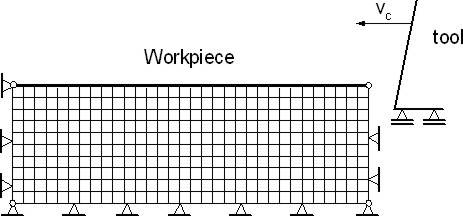
engineering & technology publications
ISSN 1759-3433
PROCEEDINGS OF THE EIGHTH INTERNATIONAL CONFERENCE ON COMPUTATIONAL STRUCTURES TECHNOLOGY
A Finite Element Model of Orthogonal Cutting
Department of Machine Technology, Silesian University of Technology, Gliwice, Poland
The FE modeling of chip formation process was performed using the MSC.Marc code which offers the ability to make simulations of mechanical events, heat transfer analysis and the modeling of heat generation due to plastic work and friction forces. A scheme of the FE model is shown in Figure 1. The plane strain state is assumed in simulations.
The paper shows chip formation process during cutting carbon steel. This steel was modeled as an isotropic elastic-plastic material. The simulation included chagnes in the Young's modulus as a result of temperature variation. Flow stress was calculated according to the Johnson - Cook equation [1,2]. Similar to the mechanical properties, temperature dependent thermal properties of the material were entered into the MSC.Marc code. Research has shown that the friction coefficient in cutting conditions depends on normal stress between surfaces being in contact (rake face and chip). It has been shown [3] that friction coefficient decreases exponentially when the normal stress increases. According to this study friction model was used in simulation. Heat transfer conditions in cutting zone were entered according to reference [4].
In results of simulations values have been obtained for the cutting force
components
![]() and
and
![]() acting on the rake face. The force
acting on the rake face. The force
![]() is acting along the cutting velocity
and
is acting along the cutting velocity
and
![]() is acting along the feed velocity.
is acting along the feed velocity.
The modelling presented gives the possibility of determining the influence of feed, rake angle and cutting velocity on cutting force components in the cutting process. The modelling shows that, as expected, rake angle and feed have a strong influence on the values of the cutting force components.
- 1
- S.P.F.C. Jaspers, J.H. Dautzenberg: "Material behaviour similar to metal cutting: flow stress in the primary shear zone", Journal of Material Processing Technology 122, 2002. doi:10.1016/S0924-0136(01)01228-6
- 2
- H. Zhao, "A constitutive model for metals over a large range of strain rates. Identification for mild-steel and aluminum sheets", Materials Science and Engineering A230, 1997. doi:10.1016/S0921-5093(97)00024-5
- 3
- M.F. Polietika, "Interaction on cutting tool areas", Maszinostrajenie, Moscow 1969 (in russian).
- 4
- W. Grzesik, The bases of cutting metal materials. Warsaw WNT 1998.
purchase the full-text of this paper (price £20)
go to the previous paper
go to the next paper
return to the table of contents
return to the book description
purchase this book (price £140 +P&P)
